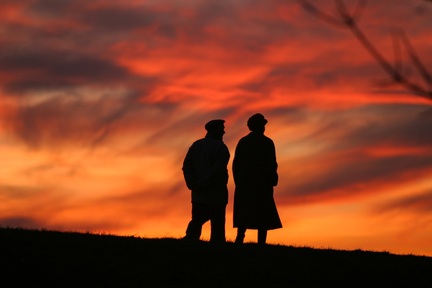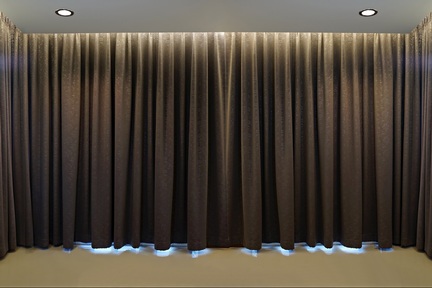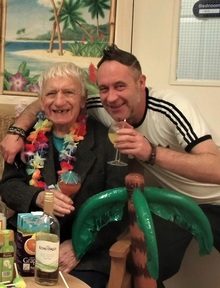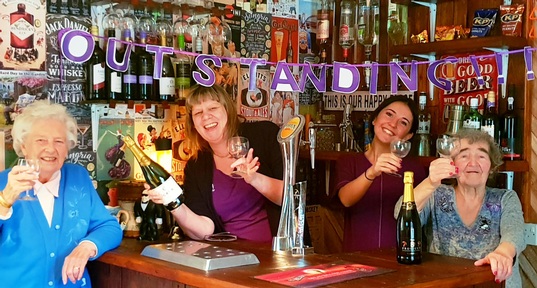Sundowning and dementia: 'Staff pull curtains before dusk' to reduce anxiety in residents
Understanding why an individual with dementia demonstrates challenging behaviour in the late afternoon and early evening can help care homes deliver on person-centred care.
Little things such as drawing the curtains before dusk to reduce the anxiety of residents can also make a difference in the quality of life for those with dementia, according to Adam Smith, consultant Admiral nurse at Colten Care.

Sundowning, or ‘late-day confusion’ as it’s sometimes known, is not a medical diagnosis but “more of a collection of presentation and symptoms exaggerated from the original dementia”, and Mr Smith is the first to admit: “I don’t think there are huge amounts of research into what sundowning is and what causes sundowning.”
Circadian rhythms trigger ‘innate stress’ during ‘sundowning hours’
The term sundowning is more commonly alluded to in the States but even there it’s generally a group of loosely collected ideas about how older people, and especially those with dementia, demonstrate certain behaviours later in the day.
Many people within care, including Mr Smith, believe the presentation of challenging behaviour from late afternoon onwards, can often be linked to man-made alterations to a person’s circadian rhythms.
Mr Smith says: “In terms of what causes it [sundowning], there is this mindset that at around 4 – 7 o’clock late afternoon and the evening, we are all so busy in life generally.”
Circadian rhythms are twenty-four hour cycles occurring naturally in humans and other animals to help them anticipate events within the day-night cycle. As human beings we have this natural rhythm, but we also have a learnt clock, where we need to do things at a certain time of day.
Mr Smith believes that sundowning happens largely because this man-made part of the day carries extra stresses for all of us at the end of a busy working day.
He explains: “Lots of people are at work at that time, they are picking children up, they are getting home from work, cooking dinner, and there’s something innate in all of us at that time of the day, when the sun’s going down as well, this time of day causes this innate sense of stress in us, this kind of nature-versus-nurture."
Care home residents were also once busy with these types of activities, and if they have dementia, their minds may revert back to their youth and when they had to juggle work with family life. Mentally returning to this time of day in their youthful lives can therefore make residents become agitated or anxious.
Mr Smith says: “We see people up and about more, trying to go home, trying to leave where they are. Others don’t want to sit still necessarily. Eating and drinking; hydration support becomes very difficult, engagement in activities becomes more difficult."

Understanding the person behind ‘trailing and checking’ behaviour
Sundowning can happen to older people or those with cognitive conditions anywhere, but there are specific ramifications for when it happens in a care home environment.
Mr Smith finds the term sundowning itself quite derogatory. He says: “It’s this label we give, and an excuse to say, ‘oh it’s okay, that resident is just sundowning’, when it’s not. We need to get to the bottom of the problem”.
"Getting to the bottom" of things, according to the Admiral nurse, is understanding the person behind the behaviour; why does their behaviour ‘deteriorate’ at a certain time of day?
Mr Smith explains further: “At one of our Colten Care homes in Winchester, on the ground floor where we’ve got our residents who have dementia, but who are still quite able, there’s a school down the road, so at about 3 or 4 o’clock you get all the school children walking past.
“Often we’ll see residents becoming quite unsettled at this point because they are going back to a time where they had to collect their children or be at home for their children.”
The nurse believes that by identifying the root cause, staff can then understand the reason behind triggers. Life-story work, dementia care-mapping, and other person-centred care approaches can be utilised rather than just labeling a person as aggressive.
This approach also works with trailing and checking.
Mr Smith says: “I hate the term, but there is a phenomenon in care homes often referred to as ‘trailing and checking’, so you’ll have an individual that’s perhaps looking for something, or looking to get out, and then other residents will follow, creating this ‘trail’ of residents.
This can be confusing for the dementia resident and tiring and upsetting for members of staff or family, and Mr Smith believes it can worsen during sundowning hours and spread throughout the care home environment.
He says: “It happens because there’s that one person who wants to get home; they think they’ve got to pick up their children, cook dinner for their husband, and other residents think, ‘where are they going, are they going somewhere I need to go’, and residents will then follow that other resident around."
Pulling curtains before dusk “helps with day-night issues”
Although Mr Smith believes learning about the individual is the best approach to understanding sundowning, he also has some practical suggestions that can easily be carried out by care home workers within a residential environment.

He says: “By that time of the day, people are tired, perhaps they’ve had a poor night’s sleep, they’ve been up early in the morning or had a disturbed day, and sometimes dehydration has a part to play. We know that for lots of older people and those with dementia, nutrition and hydration is very difficult to get right so, at this point of the day, people are running on very low reserves.”
Another question that staff can ask themselves is: “Is pain an issue at this part of the day when residents have been up and about for a long time?”, according to the Admiral Nurse.
Medication should also be reviewed. If a resident has had medication in the morning, especially something like analgesia medicine, is that wearing off at this point?
Perhaps one of the most key things to consider is the process of dusk itself.
When dusk falls the light is very poor and it changes our perceptions of what we are seeing, and this is exaggerated for someone with dementia.
Dusk - the process of day turning into night – is a cause of anxiety for many care home residents, who start to dread long dark evenings earlier on in the day. Mr Smith, however, anticipates this anxiety. He explains: “This is why I advise care homes staff pull the curtains before dusk, to help with any day/ night issues.”
Mr Smith believes person-centred approaches, combined with practical day-to-day assessments of the care home environment, are the best ways of helping individuals who become stressed from late afternoon onwards.
In his role as consultant nurse at Colten Care he is well-placed to look more closely at the phenomenon of sundowning within care homes and hopes to share any future observations on the subject within the industry.
Latest Innovative Care News
 13-May-19
'Pink drink' brain cancer treatment rolled out across NHS in memory of Baroness Jowell
13-May-19
'Pink drink' brain cancer treatment rolled out across NHS in memory of Baroness Jowell
 25-Apr-19
Louis Tomlinson helps 83-year-old who lost wife to dementia complete bucket list
25-Apr-19
Louis Tomlinson helps 83-year-old who lost wife to dementia complete bucket list
 22-Mar-19
UK's top care home handyman takes residents to pub for pie and pint
22-Mar-19
UK's top care home handyman takes residents to pub for pie and pint
 12-Feb-19
Michael McIntyre's jokes tested to see if they stop elderly catching flu
12-Feb-19
Michael McIntyre's jokes tested to see if they stop elderly catching flu
 07-Jan-19
'We were lucky to find it': Family's delight as care home is rated Outstanding
07-Jan-19
'We were lucky to find it': Family's delight as care home is rated Outstanding